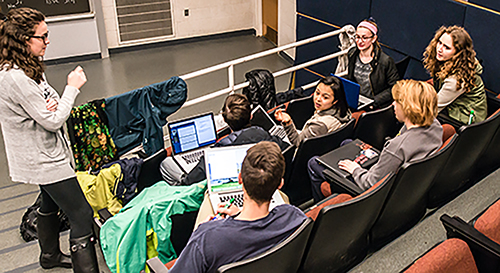Recent student activism and statements on diversity from academic leaders have led many U-M instructors to focus new attention on inclusive teaching, seeking ways to ensure all students feel welcome and able to succeed in their classes, regardless of race, ethnicity, or socioeconomic status. CRLT provides many resources to help you develop inclusive teaching strategies for your particular teaching context. To browse those, click on the 'Equity-focused Teaching' link under 'Resources'.
 In this blog, we focus on one strategy for creating an inclusive learning environment: encouraging productive student interactions in your classrooms, particularly when using small groups.
In this blog, we focus on one strategy for creating an inclusive learning environment: encouraging productive student interactions in your classrooms, particularly when using small groups.
Some of the best in-class learning takes place in small group activities, which can be very effective for prompting all students to engage actively with the course material. Some instructors nonetheless have found that efforts to encourage engaged learning through peer interaction can sometimes exacerbate students' experiences of identity-based exclusion. This can be a real danger where groupwork is used spontaneously with little guidance or follow-through. If, for instance, an instructor casually instructs students to 'get into groups' and then turns her or his own attention elsewhere, many students who already feel marginalized in the class may find it easier to sit alone than to seek out peers to share with.
It's therefore important to deliberately form and carefully guide student groups, even when you're just using a brief informal peer conversation to get students engaged in thinking about a topic. What are some specific strategies for doing so? The following practices can help ensure that student groups are primed to include all students:
- Get things off to a good start by structuring and enforcing collaborative learning early in the semester (or whenever you introduce groupwork).
- Define for or with students the characteristics of productive collaborative learning in your course. This can be an important step even if you only plan to use spontaneously-formed small groups periodically. These sample discussion guidelines might give you a place to start.
- Encourage students to form groups with others they did not know before the class, or have not worked with in a group before. Such instructions give students incentive and opportunity to connect with others who may fall outside of their usual social circles.
- Give students some time to collect thoughts in writing before sharing them with peers.
- Use small groups (no more than 3-4 people), where any one student is less likely to be marginalized.
- Identify roles for the group members so everyone has a particular task to do and specific way to contribute.
- While groups are working during class, circulate in the room to make sure everyone is connected with a group, follow up afterwards with feedback about what went well with the groups and what could be improved next time, and reiterate the importance of everyone contributing. Students will be more committed to group work--and more comfortable with it--if they see your commitment to making sure groups work well for their learning.
For some of the research on student learning supporting such suggestions, see this Cooperative Learning page. For additional strategies, see these guidelines and this list of resources for using groups effectively. For longer-term group work, see CRLT's Occasional Paper no. 29; it focuses primarily on student teams in engineering but explains principles relevant to a wide range of courses.
For guidelines focused specifically on discussing controversial topics in your course, see this page. To receive additional posts on inclusive teaching, you can subscribe to this blog at the links along the right side of our home page.
Image credit: Claudio Rocchini on Wikimedia
- Log in to post comments
- 3071 views








